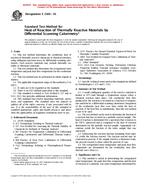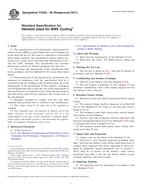1.1 This practice covers a procedure for estimating the fathead minnow (Pimephales promelas) 96-h LC50 of nonreactive (that is, covalently bonded without unsaturated residues) and nonelectrolytic (that is, require vigorous reagents to facilitate substitution, addition, replacement reactions and are non-ionic, non-dissociating in aqueous solutions) organic chemicals acting solely by narcosis, also referred to as Meyer-Overton toxicity relationship.
1.2 This procedure is accurate for organic chemicals that are toxic due to narcosis and are non-reactive and non-electrolytic. Examples of appropriate chemicals are: alcohols, ketones, ethers, simple halogenated aliphatics, aromatics, and aliphatic substituted aromatics. It is not appropriate for chemicals whose structures include a potential toxiphore (that structural component of a chemical molecule that has been identified to show mammalian toxicity, for example CN is known to be reponsible for inactivation of enzymes, NO
Product Details
- Published:
- 02/10/1997
- Number of Pages:
- 2
- File Size:
- 1 file , 26 KB


